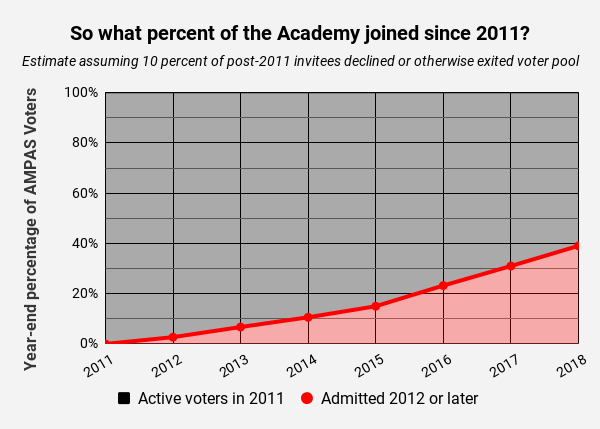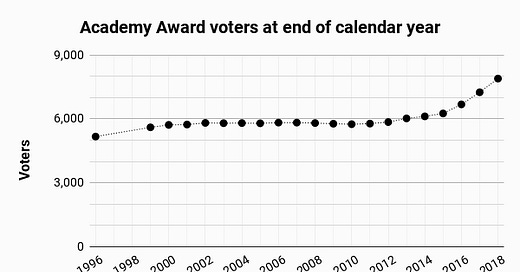Numlock Awards Supplement: What Is The Academy?
The Numlock Awards Supplement is your one-stop awards season update. You’ll get two editions per week, one from Not Her Again’s Michael Domanico breaking down an individual Oscar contender or campaigner and taking you behind the storylines, and the other from Walt Hickey looking at the numerical analysis of the Oscars and the quest to predict them. Look for it in your inbox on Saturday and Sunday mornings. Today’s edition comes from Walter.
It’s pretty well-known at this point that the Academy of Motion Picture Arts and Sciences, the organization behind the Oscars, has expanded in recent years to better reflect the industry it seeks to honor. This is a really good thing, generally speaking: the Academy dropped the ball for decades and failed to react to major shifts in the movie business and was worse for it. While generally reported on — the annual headline of the largest-ever class of inductees has become a recurring staple of the awards off-season — I think it’s generally lost on how it’s fundamentally altered the electorate of the Oscars. I say this setting aside the demographic differences between the new inductees and the old guard, which I think are slightly overstated.
By my reckoning, roughly two out of every five Academy voters have joined the organization since 2011.
That is a seismic shift, and one that I contend will lead to an electoral inflection point: essentially, a time when the recent reliable ways of forecasting Academy behavior will no longer work. We know that guild awards and precursors and critic awards help us infer the likeliest outcomes of the Oscars. The weights we assign to those need to be called into question immediately. Previous models have used the 25-year reliability of precursor prizes to inform Oscar weights. I think it’d be nuts to use much more than 10 years at this point.
But set aside the implications. Who is the Academy?
The organization is comprised of several branches — directors, actors, sound, designers, and so on — who decide who to admit and who not to. AMPAS is super coy about how many active members it has, but I tracked down historical copies of the Academy press releases and linked them to some truly outstanding data annually compiled by Steve Pond at The Wrap and, for the 2018 data, GoldDerby, to build this dataset of the number of Academy voters at the end of every year:

There are 2,147 more voters at the end of 2018 than there were in 2011, the last year that the Academy held voting membership below 6,000 people.
But that doesn’t even illustrate the significance of these moves. Consider that, despite the fact that the net voter count has increased by 2,147, there have been 3,430 people invited to join the Academy from 2012 on to 2018.
What gives?
Three things, mainly. Believe it or not, some people don’t accept the invitation to join AMPAS and become an Oscar voter. For instance, Viggo Mortenson was invited back in 2007 after getting nominated for Eastern Promises, but didn’t join. He later relented and signed up when he presumably realized it helps to be in it if you want to win it. Second, people retire from active status in the Academy and forgo voting. And third, people die. Death makes it difficult to vote for the Oscars.
This means, though, that the new members account for much more of the Academy than the raw invitees would indicate. Let’s look at the most severe case: let’s assume that every single person who’s invited joins, and that everyone who exits the voter pool through retirement or through death or what have you was in the Academy in 2011. What would 2018’s voter pool look like in that case?

That’s massive, nearly 45 percent of the Academy would have joined since 2011! Imagine trying to predict a mayoral election in a city where 45 percent of the electorate wasn’t a resident seven years ago. Would you use a voter model developed eight years ago?
Still, naive guesstimate! Let’s tweak that a bit and dial it back. Skip to the end of this paragraph if you get bored, I’ll try to keep the next part brief. Based on in memoriam data, about 1.5 percent of the Academy dies every year. Based on data of the number of retirees from 2012 to 2018, I would estimate that the net number of retirees rises by just under 40 members per year. There’s still some unexplained attrition, but it’s been on the rise since 2011, just as the number of invitees has been on the rise. So I’m going to suppose that a certain percentage of invitees decline the chance to join AMPAS, and I’m going to estimate that percentage stays relatively fixed.
I’m going to estimate 10 percent of invitees either decline or exit. Here’s then what the composition of the Academy looks like:

Still a massive chunk!
Rather than 43 percent, it’s 39 percent added since 2011.

This is the most important story in Oscar forecasting in a long time. What used to signal winners at the Oscars — be they mathematical indicators or conventional wisdom about how to pick winners — may be uncoupling from the actual electorate.
I’m going to go deeper on a few of these in the next few weeks (so subscribe!) but my key points are:
The Academy has measurably changed in a very short time, and even setting aside demography this change is enormous.
Using 25-year reliability is insane now. It used to be fine, when the number of members in the Academy was largely unchanged from (at least) 1996 through 2011. That’s not the case anymore, so savvy and adaptable models need to adjust their timespan to reflect that.
Critics groups have not, on the whole, added a commensurate number of newcomers. Guilds — where membership is determined by presence in the industry, not recognition by gatekeepers — may become better.
With Best Picture decided by ranked choice voting, we’ve got to be more sophisticated about how this upheaval impacts ranked choice and how those rankings inform outcomes.
The balance of power for branches has changed. Actors were just over 20 percent of the Academy in 2011, now they’re 16.5 percent. The documentary branch has tripled in size. While the Academy grew by 37 percent, some branches grew slower and some grew much, much faster. We need to start weighting by branch now.
More on all these in the next few weeks! Next week: Globes? I guess? Happy New Year!

